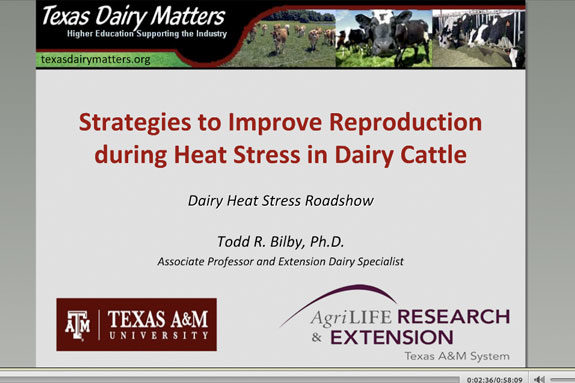On March 5, Todd Bilby, associate professor and extension dairy specialist with Texas AgriLife Research and Extension, presented a webinar on a topic that affects dairy cattle across the country during the summer – heat stress. The webinar titled “Strategies to Improve Reproduction During Heat Stress in Dairy Cattle” was the first in a series of four webinars relating to heat stress made possible by an Agriculture and Food Research Initiative competitive grant from the USDA.
The overall focus of Bilby’s presentation was on reproductive strategies for producers and consultants to consider employing on dairies during summer months to mitigate summer’s negative effects. He began his presentation by pointing out how heat stress occurs throughout the U.S., not only in southern states, as many people believe. He reviewed a few instances in the past where the negative effects of heat stress on reproduction and milk quality caused large economic losses to dairies across the country. Click here to watch the webinar.
Bilby explained that heat stress creates a lag in fertility that usually runs into the fall months. Once heat stress affects the quality of an egg, it takes close to two months (40 to 50 days) before the animal ovulates a good-quality egg that could possibly result in an embryo, he stated.
Additionally, Bilby discussed how embryo development was impacted by heat stress. He reviewed studies from the University of Florida that demonstrated how embryos are very susceptible to heat stress during the first two to three days of life. He recommended devising strategies to help the early-growing embryo bypass those heat stress events.
The presentation was then divided into four reproductive strategy areas: natural service breeding vs. A.I., synchronization and timed A.I., use of hormonal therapy to induce ovulation and improve fertility, and embryo manipulation and transfer.
Natural service vs. A.I.
Bilby highlighted a study that demonstrated how sperm motility decreased the longer a bull was under heat stress conditions. The same study also demonstrated that abnormal spermatozoa increased and spermatozoa concentration decreased as heat stress increased. Just like cows, it takes close to two months for the bulls to return to a normal fertility and start producing normal, motile spermatozoa, Bilby stated.
Because a large portion of producers use bulls in clean-up programs after three or four A.I.s, Bilby recommended that producers evaluate whether to spend more time artificially inseminating while continuing to use bulls or getting rid of bulls altogether.
If bulls were used, he suggested managing the bulls aggressively, which includes performing breeding soundness exams. He noted that the negative effects of heat stress when using bulls could be bypassed by using an A.I. program rather than natural service.
Synchronization and timed A.I.
Bilby presented studies showing the differences and results of using timed A.I. (TAI) programs as opposed to breeding cows based on estrus detection. With TAI programs, 100 percent of the animals would be inseminated, whereas a lower number of animals would be bred if breeding were based solely on estrus expression.
He recommended that producers consider implementing a full TAI program during summer months and, during the winter months, use an estrus detection program within a synchronization program to improve fertility.
Hormonal therapy
Bilby continued on to the next strategy consisting of using hormonal therapy (hCG, GnRH) at estrus and post-A.I. to induce ovulation, increase progesterone levels and ultimately improve fertility of cows during the summer.
He also pointed out how ovulation failure increased during summer months, noting that even if a cow did show estrus, that didn’t necessarily mean that she would ovulate to that estrus.
Two studies demonstrated a significant improvement of conception rates if using hormonal therapy at day four or day five after A.I. Two additional studies analyzed the effect of using hormonal therapy on day five and again day 12 after A.I.
Bilby advised that, although the use of hormonal therapy at the time of A.I. or after could improve fertility during summer months, there were currently inconsistencies in study results.
Embryo manipulation and transfer
Utilizing embryo transfer technology was another way to improve reproduction during the summer months. Bilby described a study conducted by one of his graduate students where in vitro embryo production was utilized along with sexed semen as part of an embryo transfer system.
As part of the study, eggs were sorted so that only good-quality eggs were used. The eggs were matured and then sex-sorted semen was added. Once fertilization occurred, the embryos would be cultured until they reached the blastocyst stage. At that point, some were frozen and others were transported to a dairy and transferred to the cows.
Bilby went on to describe the synchronization and treatment protocol of the study. Overall, the results showed that using fresh embryos resulted in a higher percentage of cows pregnant than using vitrified (frozen) embryos.
Although embryo transfers could improve reproduction, Bilby did point out that implementing this process on a commercial scale would have its challenges.
Bilby concluded his presentation by providing summarized take-home messages for producers. Although he didn’t discuss heat detection, Bilby stated that having an aggressive heat detection program established in addition to the strategies he presented would only help improve fertility during the summer months. PD
Click here for more information about the upcoming heat stress-related webinars remaining as part of this series or click here to see a listing of archived webinars.

-
Dario Martinez
- Editor
- Progressive Dairyman







